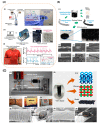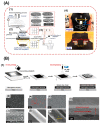Recent Advances and Challenges in Textile Electrodes for Wearable Biopotential Signal Monitoring: A Comprehensive Review
- PMID: 37504078
- PMCID: PMC10377545
- DOI: 10.3390/bios13070679
Recent Advances and Challenges in Textile Electrodes for Wearable Biopotential Signal Monitoring: A Comprehensive Review
Abstract
The technology of wearable medical equipment has advanced to the point where it is now possible to monitor the electrocardiogram and electromyogram comfortably at home. The transition from wet Ag/AgCl electrodes to various types of gel-free dry electrodes has made it possible to continuously and accurately monitor the biopotential signals. Fabrics or textiles, which were once meant to protect the human body, have undergone significant development and are now employed as intelligent textile materials for healthcare monitoring. The conductive textile electrodes provide the benefit of being breathable and comfortable. In recent years, there has been a significant advancement in the fabrication of wearable conductive textile electrodes for monitoring biopotential signals. This review paper provides a comprehensive overview of the advances in wearable conductive textile electrodes for biopotential signal monitoring. The paper covers various aspects of the technology, including the electrode design, various manufacturing techniques utilised to fabricate wearable smart fabrics, and performance characteristics. The advantages and limitations of various types of textile electrodes are discussed, and key challenges and future research directions are identified. This will allow them to be used to their fullest potential for signal gathering during physical activities such as running, swimming, and other exercises while being linked into wireless portable health monitoring systems.
Keywords: biopotentials; dry electrodes; electrocardiogram; electromyogram; smart textiles; textile electrode; wearable electronics.
Conflict of interest statement
The authors declare no conflict of interest.
Figures














Similar articles
-
Wearable E-Textiles Using a Textile-Centric Design Approach.Acc Chem Res. 2021 Nov 2;54(21):4051-4064. doi: 10.1021/acs.accounts.1c00433. Epub 2021 Oct 19. Acc Chem Res. 2021. PMID: 34665618
-
Ionic-electronic Conductive Fabric Electrodes for Wearable Biopotential Monitoring.Annu Int Conf IEEE Eng Med Biol Soc. 2022 Jul;2022:2483-2486. doi: 10.1109/EMBC48229.2022.9871717. Annu Int Conf IEEE Eng Med Biol Soc. 2022. PMID: 36086382
-
Wearable Smart Textiles for Long-Term Electrocardiography Monitoring-A Review.Sensors (Basel). 2021 Jun 17;21(12):4174. doi: 10.3390/s21124174. Sensors (Basel). 2021. PMID: 34204577 Free PMC article. Review.
-
Design, Fabrication, and Evaluation of 3D Biopotential Electrodes and Intelligent Garment System for Sports Monitoring.Sensors (Basel). 2024 Jun 25;24(13):4114. doi: 10.3390/s24134114. Sensors (Basel). 2024. PMID: 39000892 Free PMC article.
-
Recent Advances in 1D Stretchable Electrodes and Devices for Textile and Wearable Electronics: Materials, Fabrications, and Applications.Adv Mater. 2020 Feb;32(5):e1902532. doi: 10.1002/adma.201902532. Epub 2019 Sep 9. Adv Mater. 2020. PMID: 31495991 Review.
Cited by
-
A Framework for Selecting and Assessing Wearable Sensors Deployed in Safety Critical Scenarios.Sensors (Basel). 2024 Jul 15;24(14):4589. doi: 10.3390/s24144589. Sensors (Basel). 2024. PMID: 39065986 Free PMC article. Review.
-
Preliminary Study on Wearable Smart Socks with Hydrogel Electrodes for Surface Electromyography-Based Muscle Activity Assessment.Sensors (Basel). 2025 Mar 6;25(5):1618. doi: 10.3390/s25051618. Sensors (Basel). 2025. PMID: 40096459 Free PMC article.
-
Measuring Blink-Related Brainwaves Using Low-Density Electroencephalography with Textile Electrodes for Real-World Applications.Sensors (Basel). 2025 Jul 18;25(14):4486. doi: 10.3390/s25144486. Sensors (Basel). 2025. PMID: 40732614 Free PMC article.
-
Benchtop Performance of Novel Mixed Ionic-Electronic Conductive Electrode Form Factors for Biopotential Recordings.Sensors (Basel). 2024 May 15;24(10):3136. doi: 10.3390/s24103136. Sensors (Basel). 2024. PMID: 38793990 Free PMC article.
-
Tracking Upper Limb Motion via Wearable Solutions: Systematic Review of Research From 2011 to 2023.J Med Internet Res. 2024 Dec 23;26:e51994. doi: 10.2196/51994. J Med Internet Res. 2024. PMID: 39714084 Free PMC article.
References
-
- Mshali H., Lemlouma T., Moloney M., Magoni D. A Survey on Health Monitoring Systems for Health Smart Homes. Int. J. Ind. Ergon. 2018;66:26–56. doi: 10.1016/j.ergon.2018.02.002. - DOI
Publication types
MeSH terms
LinkOut - more resources
Full Text Sources

